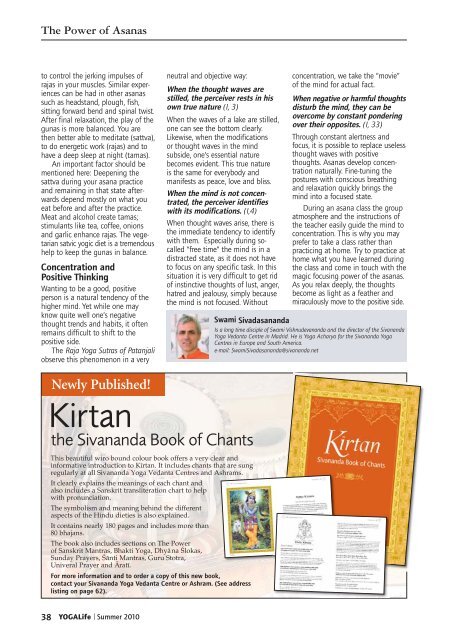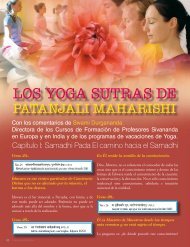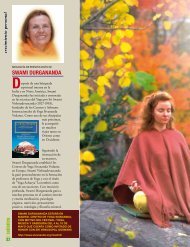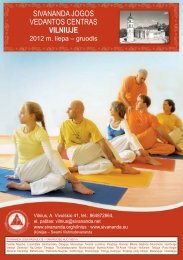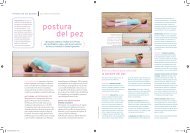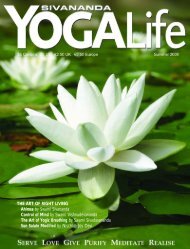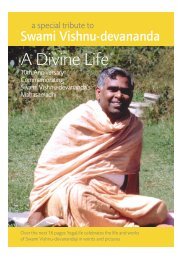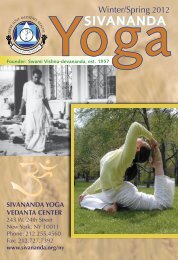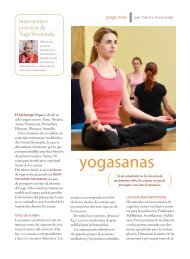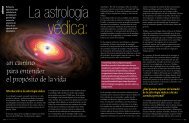YOGALife I Summer 2010 - Sivananda Yoga
YOGALife I Summer 2010 - Sivananda Yoga
YOGALife I Summer 2010 - Sivananda Yoga
Create successful ePaper yourself
Turn your PDF publications into a flip-book with our unique Google optimized e-Paper software.
The Power of Asanas<br />
to control the jerking impulses of<br />
rajas in your muscles. Similar exper -<br />
iences can be had in other asanas<br />
such as headstand, plough, fish,<br />
sitting forward bend and spinal twist.<br />
After final relaxation, the play of the<br />
gunas is more balanced. You are<br />
then better able to meditate (sattva),<br />
to do energetic work (rajas) and to<br />
have a deep sleep at night (tamas).<br />
An important factor should be<br />
mentioned here: Deepening the<br />
sattva during your asana practice<br />
and remaining in that state after -<br />
wards depend mostly on what you<br />
eat before and after the practice.<br />
Meat and alcohol create tamas;<br />
stimulants like tea, coffee, onions<br />
and garlic enhance rajas. The vege -<br />
tarian satvic yogic diet is a tremendous<br />
help to keep the gunas in balance.<br />
Concentration and<br />
Positive Thinking<br />
Wanting to be a good, positive<br />
person is a natural tendency of the<br />
higher mind. Yet while one may<br />
know quite well one’s negative<br />
thought trends and habits, it often<br />
remains difficult to shift to the<br />
positive side.<br />
The Raja <strong>Yoga</strong> Sutras of Patanjali<br />
observe this phenomenon in a very<br />
38<br />
Newly Published!<br />
<strong>YOGALife</strong> I <strong>Summer</strong> <strong>2010</strong><br />
neutral and objective way:<br />
When the thought waves are<br />
stilled, the perceiver rests in his<br />
own true nature (I, 3)<br />
When the waves of a lake are stilled,<br />
one can see the bottom clearly.<br />
Likewise, when the modifications<br />
or thought waves in the mind<br />
subside, one’s essential nature<br />
becomes evident. This true nature<br />
is the same for everybody and<br />
manifests as peace, love and bliss.<br />
When the mind is not concen -<br />
trated, the perceiver identifies<br />
with its modifications. (I,4)<br />
When thought waves arise, there is<br />
the immediate tendency to identify<br />
with them. Especially during socalled<br />
“free time” the mind is in a<br />
distracted state, as it does not have<br />
to focus on any specific task. In this<br />
situation it is very difficult to get rid<br />
of instinctive thoughts of lust, anger,<br />
hatred and jealousy, simply because<br />
the mind is not focused. Without<br />
Kirtan<br />
the <strong>Sivananda</strong> Book of Chants<br />
This beautiful wiro bound colour book offers a very clear and<br />
informative introduction to Kãrtan. It includes chants that are sung<br />
regularly at all <strong>Sivananda</strong> <strong>Yoga</strong> Vedanta Centres and Ashrams.<br />
It clearly explains the meanings of each chant and<br />
also includes a Sanskrit transliteration chart to help<br />
with pronunciation.<br />
The symbolism and meaning behind the different<br />
aspects of the Hindu dieties is also explained.<br />
It contains nearly 180 pages and includes more than<br />
80 bhajans.<br />
The book also includes sections on The Power<br />
of Sanskrit Mantras, Bhakti <strong>Yoga</strong>, Dhyàna ølokas,<br />
Sunday Prayers, øànti Mantras, Guru Stotra,<br />
Univeral Prayer and âratã.<br />
For more information and to order a copy of this new book,<br />
contact your <strong>Sivananda</strong> <strong>Yoga</strong> Vedanta Centre or Ashram. (See address<br />
listing on page 62).<br />
concentration, we take the “movie”<br />
of the mind for actual fact.<br />
When negative or harmful thoughts<br />
disturb the mind, they can be<br />
overcome by constant pondering<br />
over their opposites. (I, 33)<br />
Through constant alertness and<br />
focus, it is possible to replace useless<br />
thought waves with positive<br />
thoughts. Asanas develop concen -<br />
tration naturally. Fine-tuning the<br />
postures with conscious breathing<br />
and relaxation quickly brings the<br />
mind into a focused state.<br />
During an asana class the group<br />
atmosphere and the instructions of<br />
the teacher easily guide the mind to<br />
concentration. This is why you may<br />
prefer to take a class rather than<br />
practicing at home. Try to practice at<br />
home what you have learned during<br />
the class and come in touch with the<br />
magic focusing power of the asanas.<br />
As you relax deeply, the thoughts<br />
become as light as a feather and<br />
miraculously move to the positive side.<br />
Swami Sivadasananda<br />
Is a long time disciple of Swami Vishnudevananda and the director of the <strong>Sivananda</strong><br />
<strong>Yoga</strong> Vedanta Centre in Madrid. He is <strong>Yoga</strong> Acharya for the <strong>Sivananda</strong> <strong>Yoga</strong><br />
Centres in Europe and South America.<br />
e-mail: SwamiSivadasananda@sivananda.net


